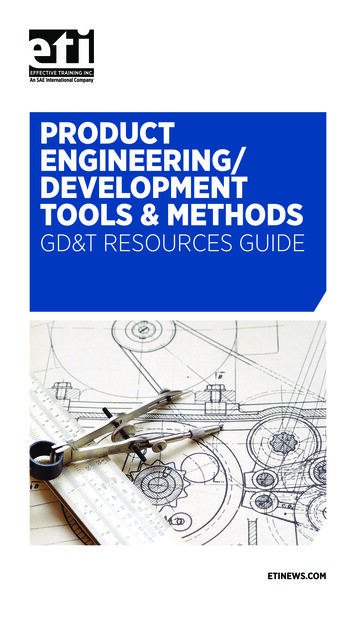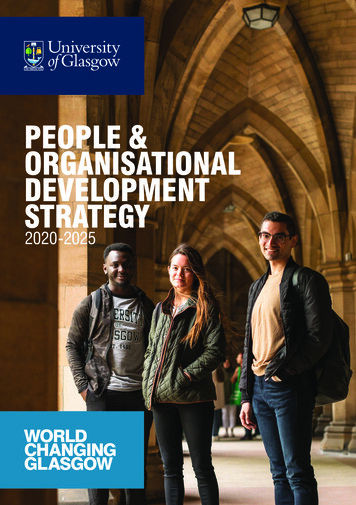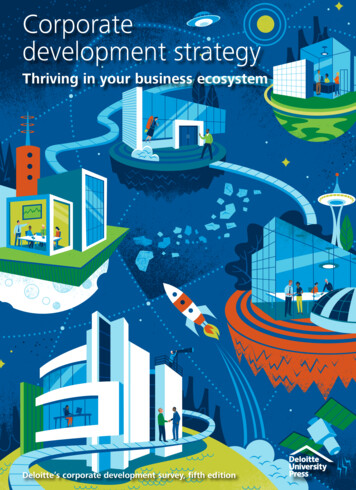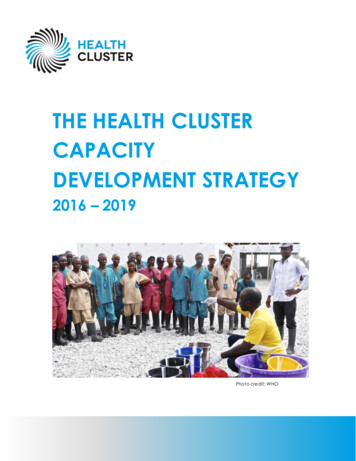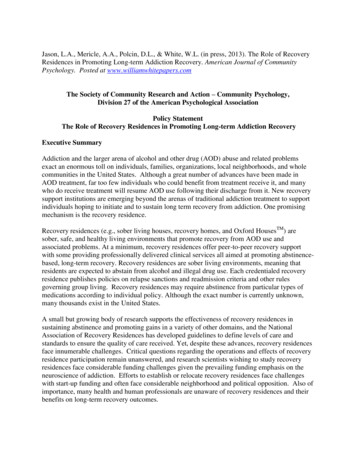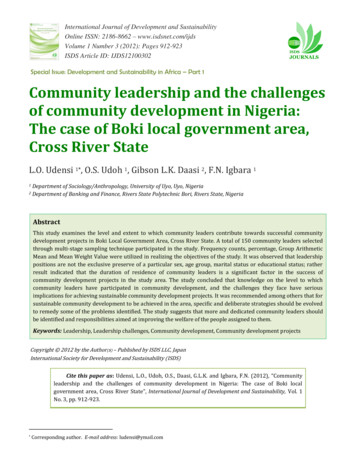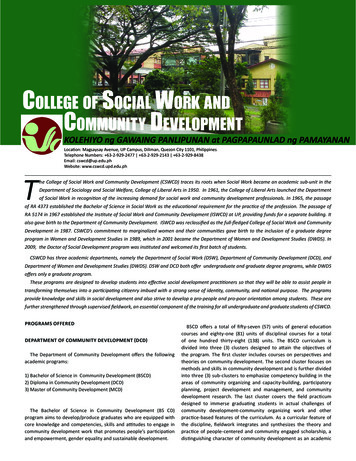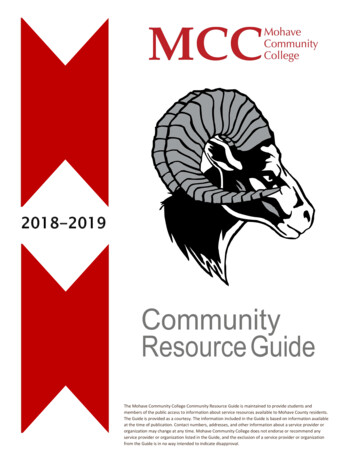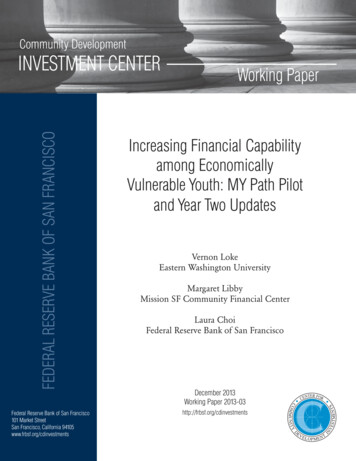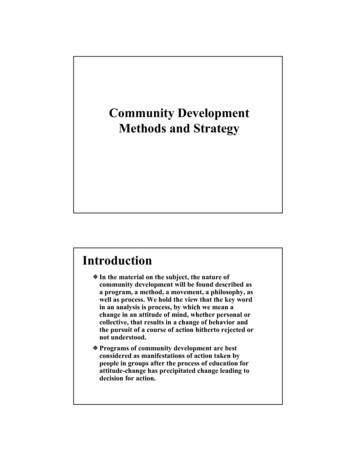
Transcription
Community DevelopmentMethods and StrategyIntroductionIn the material on the subject, the nature ofcommunity development will be found described asa program, a method, a movement, a philosophy, aswell as process. We hold the view that the key wordin an analysis is process, by which we mean achange in an attitude of mind, whether personal orcollective, that results in a change of behavior andthe pursuit of a course of action hitherto rejected ornot understood.Programs of community development are bestconsidered as manifestations of action taken bypeople in groups after the process of education forattitude-change has precipitated change leading todecision for action.1
IntroductionIf it is accepted that the distinguishing characteristic ofcommunity development is the educational process bywhich people change themselves and their behavior,and acquire new skill and confidence through workingin cooperation, we must then examine the method usedto stimulate this process by community developmentworkers.Community Development MethodTo stimulate the movement from being to becomingwhich we have called process, a movement whichbrings about a change in attitude, the worker incommunity development uses at least three tools:His own personalityThe relationships he creates with peopleVarious vehicles of communication.A worker endeavors to help the people to learn skillswhich reinforce these attitudes and promote attitudechange.2
Community Development MethodInitial Contact and Creating Rapport withCommunity MembersThis initial contact may be made with individuals orwith a contact group, and is generally establishedwith persons already disposed to welcoming andtalking with the worker, either because they feelsufficiently confident to do so or perhaps spill overinto urgent expression, and they want to talk to asympathetic listener.The community worker has to create and sustainwith persons and groups many relationships whichare both simultaneous and independent of oneanother.Community Development MethodInitial Contact and Creating Rapport withCommunity Members (cont.)The skill required to work in a complex nexus ofrelationships will be understood when it isremembered that in communities, individuals andgroups may be fearful of one another, or hostile toeach other, while engaged in varying degrees incommunity activities.The workers has to maintain relationships with eachwithout arousing mistrust or jealousy when personsor groups may expect to receive his exclusiveattention or loyalty.3
Community Development MethodInitial Contact and Creating Rapport withCommunity Members (cont.)The form of initial contact may be unstructured, theworker making a habit of being around andaccessible in a community meeting place to watch thepassersby and enjoy their company, until such timeas both curiosity and familiarity prompt the firstexchange of greeting, comment, or inquiry.Contact may be made through a group, structured toafford the community the help of the worker insolving some pressing need.Community Development MethodSystematic DiscussionThe second step in the sequence of method comeswhen the people ask the worker to help them resolvetheir problems and meet their needs. By helpingpeople to express themselves they can better focusfeelings and thereby define more precisely the causeof their discontent.The degree of help required, and the time needed tomove toward remedial action, depends on the socialstructure and values as well as on the sophisticationof the community and its capacity to grow incommunity consciousness.4
Community Development MethodSystematic Discussion (cont.)Beyond these initial stages lies the task of analyzingthe nature of the needs and problems, assessing what isrequired to deal with them, and deciding whichresources can be used for the purpose.Systematic discussion is necessary to establish whatare the commonly felt needs, and which are to be givenpriority in the light of objective analysis.The worker does offer only a point of view and not adecision for the people.Community Development MethodSystematic Discussion (cont.)Every worker will independently have made somepreliminary investigations of the community inwhich he is to work, and have taken steps to informhimself of basic data on the community.Native wisdom, the know-how which comes fromintimate and long acquaintance with the localenvironment and climate, has too often been ignoredby community development workers coming fromoutside the community with their imagined superiortechnical knowledge.5
Community Development MethodPlanning and ExecutionThe third step in the sequence is to plan the workto be done, and to parcel out the tasks forexecution.Within the long-term perspective of communitydevelopment as an educational process, short-termprojects or campaigns of limited duration are thevehicles of community action because intensefeelings of involvement cannot be sustainedindefinitely, and it is important to plan communityaction, not only to coincide with initial enthusiasm,but to accord with the rhythm of the ebb and flowof human endeavor.Community Development MethodPlanning and Execution (cont.)Enthusiastic beginnings can be supported, butcommunity workers should aim to protect people fromoverreaching themselves, from their vulnerability toearly disappointment and loss of heart when workdemands more effort than anticipated, and an earlyfulfillment of their hopes proves to be elusive.By persuasion, they can try to establish more modesttargets and help to plan the execution of a project inmanageable stages of development.6
Community Development MethodPlanning and Execution (cont.)The worker is aware that in the communitydevelopment process, the educational experience ofthe people and their growth and development, bothas persons and as a community, in terms ofcooperation and the maturation of their commonrelationships, is more important than the contentof the program or projects undertaken.Insofar as he can, a worker should guard againstthe possibility of protecting people from learningthrough painful experience. The workers tend to beoveranxious, not least in those programs where theyare subject to pressure from above to achievecertain targets.Community Development MethodPlanning and Execution (cont.)The work will be done without damage tocommunity self-esteem if workers help people toplan carefully; to phase the execution of a project;and to make the kind of decision about what theywant to do that would comprehend the discipline ofthe situation, requiring completion of a task withina reasonable time and with a reasonable outlay ofeffort to which no one can reasonably object.No worker can guarantee success. With ourpresent limited knowledge of human behavior andits motivations, the worker and the people mustlive in imperfect knowledge of themselves.7
Community Development MethodConclusion of ProjectConclusion and evaluation constitute the forth step inthe sequence. This action in turn, provides the seed fora further undertaking of community action.While celebration is desirable to mark the conclusionof a satisfactory project, there is a danger that moreattention may be given to the function and theoccasion than is warranted. Workers, under pressureto show results, have been known to present falsestatistics and to recommend for awards people notqualified as literate.Community Development MethodConclusion of Project (cont.)The worker’s daily routine should be seen in terms ofthe should process of community development. Suchperspective is enhanced by the skill of record-keeping,by his professional relationships with his supervisor orsupervising committee, and by the concurrentevaluation which both afford.The record-keeping, supervision and evaluation arepart of worker’s method of developing his professionalself, but during a project they also contribute tohelping the community make its own evaluation.8
Community Development MethodConclusion of Project (cont.)The worker’s skill in leading, stimulating, andsupporting group discussion, his work in committee,his relationships with people in the community – allcontain the ingredients of evaluation.It appears simple enough to conceive of communitydevelopment method as making contacts throughrapport, establishing ongoing relationships, workingwith people through group discussion to interprettheir needs and problems, and finally helping themto carry out appropriate action to satisfactorycompletion.Community Development MethodConclusion of Project (cont.)In fact, the method is made complex in application.Some of the complicating factors include thepersonality of the worker, the group personalityevolved by people in various task groups, theparticular profile of the community, the alternativechoices of action facing the community to meet theirneeds and problems.We also need to consider other factors, such ascontext and form, organizational andadministrative, which we may term communitydevelopment strategy.9
Community Development StrategiesCollaborative StrategyThere are two major problems with communitydevelopment are:Outside workers making decisions about what would bebest for the community.The organizations sponsoring community developmentprograms losing touch with them, finding themthreatening, and then discontinuing them.The community development strategies are aimed tosolve the problem of outsiders deciding what shouldhappen within the community.The collaborativeparticipation opens communication and helpsreduce resistance to change created by thecommunity development program.Community Development StrategiesAction Research StrategyMost community groups do not seem to pay muchattention to researching their communitystructure, problems or process. The particularcharacteristics which differentiate action researchfrom other research methods are examined andrelated to a value orientation which is seen to becompatible with the values underlying communitydevelopment.Because of the many different kinds of communityaction each type of action research has its validity.It is important in choosing the type of actionresearch best suited to the needs of any particularcommunity action.10
Community Development StrategiesEducation StrategyAccording to the gains to be expected fromcommunity action are in terms of the value as aneducational experience rather than in terms of anyspecific achievements in administrative change.The community worker helps people criticallyreexamine the society in which they find themselves,to understand the ways in which various politicaland administrative systems work, to acquire skills inself-organization and also more specific skills thatmay be relevant to their self-chosen projects.Community Development StrategiesProcess StrategyIt is this transmission of skills from communityworkers to citizens individually and collectively thatsupposedly leads to achievement and strengtheningof popular power.In the process of planned change, communitydevelopment intends to share or redistribute existingpower. Often it may be necessary to build a newpower structure through citizen participation andorganization.11
Community Development StrategiesLeadership StrategyAll citizen organizations to be effective require botha large membership and a dynamic cadre of leaders.There is the need for a clearly articulated programof political education that challenges capitalisthegemony so that other alternatives can be discussed.Therefore, local struggles and organizing areimportant in reaching people, educating thempolitically and dealing with their everyday problemsin the context of longer term political struggle.Community Development StrategiesIn order to increase the local capacity for independentcommunity action, and to discourage dependence ongovernment, people need some basic skills andknowledge.One of the major goals of community development isto strengthen the capacity of individuals to learn allthe time, and to remain flexible and adaptable.12
Summary & ConclusionWhat initially is a question of bringing thetechnical advice and resources of governmentdevelopment and social-service departments tothe aid of the people becomes a matter ofhelping people to continue using those services,and through use to improved them andgradually to provide and finance local orregional counterparts.The most sensitive tools of communitydevelopment are still the field agent, who is thevillage-level worker, and his relationship withthe people.Summary & ConclusionThe basic elements or components forstructuring a model program might include:The location of personal agents-of-change within theboundaries of isolated communities.Effectively organized self-help groups within localcommunities.Technical and material aid for such groups.The operation of organized and systematic channelsof communication and administration betweenagencies of technical and material assistance andorganized self-help local community groups.13
Summary & ConclusionThe keys to growth in the process of communitydevelopment are to be found in the person andpersonality for the agent-of-change, in thecapacity of the community to evolve groups ofpeople with self-help motivation, and in thechannels of communication, external to thosegroups, which lend them support,encouragement,and recognition from the largercommunity, along with the technical andmaterial help required.BibliographyBiddle, W. W. and Biddle, L.J., (1965) The community development process: Therediscovery of local initiative. Holt, New York.Campfens, H., (1997) Community development around the world. University ofToronto Press, Toronto.Stolper, W., (1966) Planning without facts. Harvard University Press. Cambridge.Symonds, R., (1966) The British and their successors: A study in the developmentof the government services in the new states. Northwestern University Press.Evanston.14
Community Development Strategies Action Research Strategy . supposedly leads to achievement and strengthening of popular power. In the process of planned change, community . The location of personal agents

